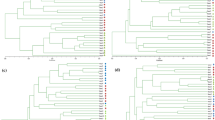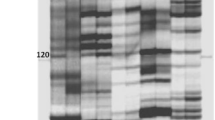Abstract
Molecular marker technologies have proven to be an important breakthrough for genetic studies, construction of linkage maps and population genetics analysis. Transposable elements (TEs) constitute major fractions of repetitive sequences in plants and offer a wide range of possible areas to be explored as molecular markers. Sequence characterized amplified region (SCAR) marker development provides us with a simple and time saving alternative approach for marker development. We employed the CACTA-TD to develop SCARs and then integrated them into linkage map and used them for population structure and genetic diversity analysis of corn inbred population. A total of 108 dominant SCAR markers were designed out of which, 32 were successfully integrated in to the linkage map of maize RIL population and the remaining were added to a physical map for references to check the distribution throughout all chromosomes. Moreover, 76 polymorphic SCARs were used for diversity analysis of corn accessions being used in Korean corn breeding program. The overall average polymorphic information content (PIC) was 0.34, expected heterozygosity was 0.324 and Shannon’s information index was 0.491 with a percentage of polymorphism of 98.67%. Further analysis by associating with desirable traits may also provide some accurate trait specific tagged SCAR markers. TE linked SCARs can provide an added level of polymorphism as well as improved discriminating ability and therefore can be useful in further breeding programs to develop high yielding germplasm.







Similar content being viewed by others
References
Bhagyawant SS (2016) RAPD-SCAR Markers: an interface tool for authentication of traits. J Biosci Med 04(01):1–9. doi:10.4236/jbm.2016.41001
Buckler ESt, Thornsberry JM, Kresovich S (2001) Molecular diversity, structure and domestication of grasses. Genet Res 77(3):213–218
Camus-Kulandaivelu L, Veyrieras JB, Madur D, Combes V, Fourmann M, Barraud S, Dubreuil P, Gouesnard B, Manicacci D, Charcosset A (2006) Maize adaptation to temperate climate: relationship between population structure and polymorphism in the Dwarf8 gene. Genetics 172(4):2449–2463. doi:10.1534/genetics.105.048603
Cheng J, Long Y, Khan MA, Wei C, Fu S, Fu J (2015) Development and significance of RAPD-SCAR markers for the identification of Litchi chinensis Sonn. by improved RAPD amplification and molecular cloning. Electron J Biotechnol 18(1):35–39. doi:10.1016/j.ejbt.2014.11.004
Collard BC, Mackill DJ (2008) Marker-assisted selection: an approach for precision plant breeding in the twenty-first century. Philos Trans R Soc Lond B Biol Sci 363(1491):557–572. doi:10.1098/rstb.2007.2170
Fedoroff NV (2012) Transposable elements, epigenetics, and genome evolution. Science 338(6108):758–767. doi:10.1126/science.338.6108.758
Finnegan DJ (1989) Eukaryotic transposable elements and genome evolution. Trends Genet 5(4):103–107. doi:10.1016/0168-9525(89)90039-5
González LG, Deyholos MK (2012) Identification, characterization and distribution of transposable elements in the flax (Linum usitatissimum L.) genome. BMC Genomics 13(1):644. doi:10.1186/1471-2164-13-644
Grzebelus D (2006) Transposon insertion polymorphism as a new source of molecular markers. J Fruit Ornam Plant Res 14(Suppl.1):21
Guo W, Zhang T, Shen X, Yu JZ, Kohel RJ (2003) Development of SCAR marker linked to a major QTL for high fiber strength and its usage in molecular-marker assisted selection in upland cotton. Crop Sci 43(6):2252. doi:10.2135/cropsci2003.2252
Han Y, Zheng D, Vimolmangkang S, Khan MA, Beever JE, Korban SS (2011) Integration of physical and genetic maps in apple confirms whole-genome and segmental duplications in the apple genome. J Exp Bot 62(14):5117–5130. doi:10.1093/jxb/err215
Khampila J, Lertrat K, Saksirirat W, Sanitchon J, Muangsan N, Theerakulpisut P (2008) Identification of RAPD and SCAR markers linked to northern leaf blight resistance in waxy corn (Zea mays var. ceratina). Euphytica 164(3):615–625. doi:10.1007/s10681-008-9647-z
Khan MA, Han Y, Zhao YF, Troggio M, Korban SS (2012) A multi-population consensus genetic map reveals inconsistent marker order among maps likely attributed to structural variations in the apple genome. PLoS One 7(11):e47864. doi:10.1371/journal.pone.0047864
Kiran U, Khan S, Mirza KJ, Ram M, Abdin MZ (2010) SCAR markers: a potential tool for authentication of herbal drugs. Fitoterapia 81(8):969–976. doi:10.1016/j.fitote.2010.08.002
Kohany O, Gentles AJ, Hankus L, Jurka J (2006) Annotation, submission and screening of repetitive elements in repbase: repbasesubmitter and censor. BMC Bioinform 7:474. doi:10.1186/1471-2105-7-474
Kraitshtein Z, Yaakov B, Khasdan V, Kashkush K (2010) Genetic and epigenetic dynamics of a retrotransposon after allopolyploidization of wheat. Genetics 186(3):801–812. doi:10.1534/genetics.110.120790
Kunze R, Weil CF (2002) The hAT and CACTA superfamilies of plant transposons, pp 565–610. doi:10.1128/9781555817954.ch24
Kwon S-J, Park K-C, Kim J-H, Lee JK, Kim N-S (2005) Rim 2/Hipa CACTA transposon display: a new genetic marker technique in Oryza species. BMC Genet 6:15. doi:10.1186/1471-2156-6-15
Kwon SJ, Hong SW, Son JH, Lee JK, Cha YS, Eun MY, Kim NS (2006a) CACTA and MITE transposon distributions on a genetic map of rice using F15 RILs derived from Milyang 23 and Gihobyeo hybrids. Mol Cells 21(3):360–366 a)
Kwon SJ, Lee JK, Hong SW, Park YJ, McNally KL, Kim NS (2006b) Genetic diversity and phylogenetic relationship in AA Oryza species as revealed by Rim2/Hipa CACTA transposon display. Genes Genet Syst 81(2):93–101. doi:10.1266/ggs.81.93 b)
Lee JK, Park JY, Kim JH, Kwon SJ, Shin JH, Hong SK, Min HK, Kim NS (2006) Genetic mapping of the Isaac-CACTA transposon in maize. Theor Appl Genet 113(1):16–22. doi:10.1007/s00122-006-0263-9
Lee S-I, Park K-C, Ha M-W, Kim K-S, Jang Y-S, Kim N-S (2012) CACTA transposon-derived Ti-SCARs for cultivar fingerprinting in rapeseed. Genes Genom 34(5):575–579. doi:10.1007/s13258-012-0190-x
Lee HM, Park YM, Jun TH, Kwon SW, Choi IS, Kim YC, Gupta R, Chung MN, Kim SH, Yang P, Wang Y, Kim ST (2015) Direct sequencing of RAPD products provides a set of SCAR markers for discrimination of sweet potato cultivars. Plant Omics 8(3):195–200
Li Q, Li L, Dai J, Li J, Yan J (2009) Identification and characterization of CACTA transposable elements capturing gene fragments in maize. Chin Sci Bull 54(4):642–651. doi:10.1007/s11434-009-0061-2
Lou Q, Chen J (2007) Ty1-copia retrotransposon-based SSAP marker development and its potential in the genetic study of cucurbits. Genome 50(9):802–810. doi:10.1139/g07-067
Meng L, Li H, Zhang L, Wang J (2015) QTL IciMapping: integrated software for genetic linkage map construction and quantitative trait locus mapping in biparental populations. Crop J 3(3):269–283. doi:10.1016/j.cj.2015.01.001
Monden Y, Naito K, Okumoto Y, Saito H, Oki N, Tsukiyama T, Ideta O, Nakazaki T, Wessler SR, Tanisaka T (2009) High potential of a transposon mPing as a marker system in japonica × japonica cross in rice. DNA Res 16(2):131–140. doi:10.1093/dnares/dsp004
Naqvi NI, Chattoo BB (1996) Development of a sequence characterized amplified region (SCAR) based indirect selection method for a dominant blast-resistance gene in rice. Genome 39(1):26–30. doi:10.1139/g96-004
Oliver KR, Greene WK (2009) Transposable elements: powerful facilitators of evolution. Bioessays 31(7):703–714. doi:10.1002/bies.200800219
Oliver KR, McComb JA, Greene WK (2013) Transposable elements: powerful contributors to angiosperm evolution and diversity. Genome Biol Evol 5(10):1886–1901. doi:10.1093/gbe/evt141
Osipova ES, Lysenko EA, Troitsky AV, Dolgikh YI, Shamina ZB, Gostimskii SA (2011) Analysis of SCAR marker nucleotide sequences in maize (Zea mays L.) somaclones. Plant Sci 180(2):313–322. doi:10.1016/j.plantsci.2010.10.004
Paran I, Michelmore RW (1993) Development of reliable PCR-based markers linked to downy mildew resistance genes in lettuce. Theor Appl Genet 85(8):985–993. doi:10.1007/BF00215038
Park JY, Sa KJ, Park KJ, Lee JK (2014) Analysis of morphological characteristics for normal maize inbred lines. Korean J Crop Sci 59(3):312–318. doi:10.7740/kjcs.2014.59.3.312
Park JY, Ramekar RV, Sa KJ, Lee JK (2015) Genetic diversity, population structure, and association mapping of biomass traits in maize with simple sequence repeat markers. Genes Genom 37(8):725–735. doi:10.1007/s13258-015-0309-y
Peakall R, Smouse PE (2012) GenAlEx 6.5: genetic analysis in Excel. Population genetic software for teaching and research–an update. Bioinformatics 28(19):2537–2539. doi:10.1093/bioinformatics/bts460
Perrier X, Jacquemoud-Collet J (2006) DARwin software http://darwin.cirad.fr/
Pritchard JK, Wen W, Falush D (2003) Documentation for STRUCTURE software: version 2. https://web.stanford.edu/group/pritchardlab/structure.html
Roy N, Choi J-Y, Lim M-J, Lee S-I, Choi H-J, Kim N-S (2015) Genetic and epigenetic diversity among dent, waxy, and sweet corns. Genes genom. doi:10.1007/s13258-015-0329-7
Roy NS, Choi J-Y, Park K-C, Kim N-S (2016) Comparison of molecular genetic utilities of TD, AFLP, and MSAP among the accessions of japonica, indica, and Tongil of Oryza sativa L. Genes Genom 38(9):819–830. doi:10.1007/s13258-016-0426-2
Rozen S, Skaletsky H (1999) Primer3 on the WWW for general users and for biologist programmers. Bioinform Method protocol 132:365–386. doi:10.1385/1-59259-192-2:365
Sa KJ, Park JY, Woo SY, Ramekar RV, Jang C-S, Lee JK (2014) Mapping of QTL traits in corn using a RIL population derived from a cross of dent corn × waxy corn. Genes Genom 37(1):1–14. doi:10.1007/s13258-014-0223-8
Semagn K, Bjørnstad Å, Ndjiondjop MN (2006) Principles, requirements and prospects of genetic mapping in plants. Afr J Biotechnol 5(25):2569–2587. doi:10.5897/AJB2006.000-5112
Shan XH, Li YD, Liu XM, Wu Y, Zhang MZ, Guo WL, Liu B, Yuan YP (2012) Comparative analyses of genetic/epigenetic diversities and structures in a wild barley species (Hordeum brevisubulatum) using MSAP, SSAP and AFLP. Genet Mol Res 11(3):2749–2759. doi:10.4238/2012.August.17.2
Son J-H, Kim K-H, Shin S, Choi I, Kim H-S, Cheong Y-K, Lee C-K, Lee S-I, Choi J-Y, Park K-G, Kang C-S (2014) Development of SCAR markers for Korean wheat cultivars identification. Plant Breed Biotechnol 2(3):224–230. doi:10.9787/pbb.2014.2.3.224
Syed NH, Flavell AJ (2006) Sequence-specific amplification polymorphisms (SSAPs): a multi-locus approach for analyzing transposon insertions. Nat Protoc 1(6):2746–2752. doi:10.1038/nprot.2006.407
Takagi K, Nagano H, Kishima Y, Sano Y (2003) MITE-transposon display efficiently detects polymorphisms among the Oryza AA-genome species. Breed Sci 53(2):125–132. doi:10.1270/jsbbs.53.125
Vandenbussche M, Zethof J, Gerats T (2013) Transposon display: a versatile method for transposon tagging. In: Peterson T (ed) Plant transposable elements: methods and protocols. Humana Press, Totowa, NJ, pp 239–250. doi:10.1007/978-1-62703-568-2_17
Vos P, Hogers R, Bleeker M, Reijans M, van de Lee T, Hornes M, Frijters A, Pot J, Peleman J, Kuiper M et al (1995) AFLP: a new technique for DNA fingerprinting. Nucleic Acids Res 23(21):4407–4414
Wicker T, Guyot R, Yahiaoui N, Keller B (2003) CACTA transposons in Triticeae. A diverse family of high-copy repetitive elements. Plant Physiol 132(1):52–63. doi:10.1104/pp.102.015743
Xie C, Warburton M, Li M, Li X, Xiao M, Hao Z, Zhao Q, Zhang S (2007) An analysis of population structure and linkage disequilibrium using multilocus data in 187 maize inbred lines. Mol Breed 21(4):407–418. doi:10.1007/s11032-007-9140-8
Yaakov B, Ceylan E, Domb K, Kashkush K (2012) Marker utility of miniature inverted-repeat transposable elements for wheat biodiversity and evolution. Theor Appl Genet 124(7):1365–1373. doi:10.1007/s00122-012-1793-y
Yin X (2003) Fine mapping of the Ht2 (Helminthosporium turcicum resis-tance 2) gene in maize. Chin Sci Bull 48(2):165. doi:10.1360/03tb9034
Zerjal T, Rousselet A, Mhiri C, Combes V, Madur D, Grandbastien MA, Charcosset A, Tenaillon MI (2012) Maize genetic diversity and association mapping using transposable element insertion polymorphisms. Theor Appl Genet 124(8):1521–1537. doi:10.1007/s00122-012-1807-9
Acknowledgements
This work was funded by a grant from the Golden Seed Project, Ministry of Agriculture, Food and Rural Affairs (MAFRA), Ministry of Oceans and Fisheries (MOF), Rural Development of Korea (RDA), and the Korea Forest Service (Project No. ATIS-PJ012650022017, FRIS-213009-05-1-WT812). We extend our appreciation to Dr. George Fedak for reading the manuscript.
Author information
Authors and Affiliations
Corresponding author
Ethics declarations
Conflict of interest
Authors declare no conflict of interest on the contents of the manuscript.
Additional information
Neha Samir Roy and Kyong-Cheul Park have contributed equally to the manuscript.
Electronic supplementary material
Below is the link to the electronic supplementary material.
Rights and permissions
About this article
Cite this article
Roy, N.S., Park, KC., Lee, SI. et al. Development of CACTA transposon derived SCAR markers and their use in population structure analysis in Zea mays . Genetica 146, 1–12 (2018). https://doi.org/10.1007/s10709-017-9985-7
Received:
Accepted:
Published:
Issue Date:
DOI: https://doi.org/10.1007/s10709-017-9985-7




